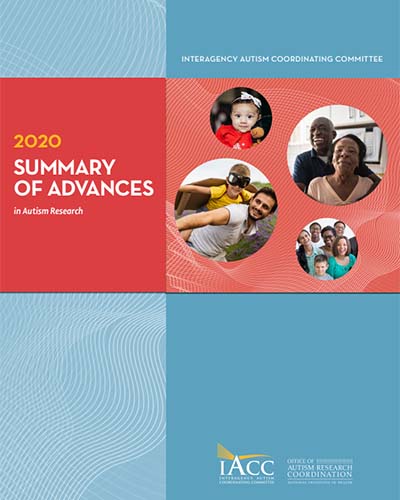Summary of Advances
In Autism Research
2020

Health Disparities Among Sexual and Gender Minorities with Autism Spectrum Disorder.
Hall JP, Batza K, Streed CG Jr, Boyd BA, Kurth NK. J Autism Dev Disord. 2020 Aug;50(8):3071-3077. [PMID: 32056117]
Autistic individuals who belong to sexual and gender minority groups report higher rates of unmet health care needs and negative experiences with providers.
Background: Both individuals with autism and individuals of sexual and gender minority experience multiple, systemic barriers to appropriate health care. Reasons for this include a lack of knowledgeable providers and fear of stigma. Individuals at the intersection of autism and sexual and gender minority may experience cumulative health disparities, but little is understood about their health and access to health care. This study sought to understand the health experiences of individuals with ASD who also identify as LGBTQ+.
Methods & Findings: The National Survey on Health and Disability (NSHD) is an internet-based survey that was implemented between February and June 2018. It provided a snapshot of health outcomes among Americans with disabilities after the implementation of the Affordable Care Act. The researchers extracted data from the NSHD data for 54 adults (aged 18-62) with ASD; of these, 19 individuals also identified as LGBTQ+ (35%). Autistic LGBTQ+ individuals were more likely to have private insurance and straight, autistic cisgender (someone whose gender is the same as their biological sex) individuals were more likely to have Medicare or Medicaid. Data from both the survey and follow-up interviews with five respondents indicated that private insurance was less adequate than Medicare or Medicaid in covering the medical needs of LGBTQ+ individuals on the autism spectrum. LGBTQ+ individuals with ASD reported much higher rates of unmet health care needs and inadequate provider networks than straight, cisgender individuals with ASD.
Implications: This study found evidence that autistic LGTBQ+ individuals lack adequate health care services and experience worse health than straight, cisgender autistic individuals. LGBTQ+ individuals with ASD report higher educational attainment but greater rates of mental illness, smoking, and poor overall health—a finding that is contrary to research of the general population. LGBTQ+ individuals with ASD are also more likely to have post-traumatic stress disorder (PTSD) than straight, cisgender individuals with ASD. The interviews indicated that LGBTQ+ individuals on the autism spectrum were often reluctant to seek health care, which was associated with previous negative experiences and provider attitudes. The results of this study indicate that health care professionals should receive training in the specific needs of LGBTQ+ individuals and LGBTQ+ individuals with ASD.
Anxiety Disorders in Adults with Autism Spectrum Disorder: A Population-Based Study.
Nimmo-Smith V, Heuvelman H, Dalman C, Lundberg M, Idring S, Carpenter P, Magnusson C, Rai D. J Autism Dev Disord. 2020 Jan;50(1):308-318. [PMID: 31621020]
Young adults on the autism spectrum are three times more likely to have an anxiety disorder than non-autistic adults.
Background: Anxiety is a common co-existing condition in autistic children; however, less is known about the prevalence and characteristics of anxiety disorder among autistic adults, both with and without intellectual disability (ID). The few existing studies on anxiety in adults with autism have reported inconsistent findings, often fail to document prevalence across distinct types of anxiety disorders, and have not addressed differences between those with and without ID. This study aimed to determine the lifetime prevalence of anxiety disorders in autistic adults and to characterize the risk of co-existing anxiety in autistic adults with and without ID. The study also aimed to determine genetic vulnerability for anxiety amongst full and half non-autistic siblings of autistic individuals.
Methods & Findings: The researchers used data from two large databases of individuals in Sweden that provide information on health and familial linkages. The researchers identified 4,049 autistic adults (aged 18 to 27) with or without ID and a reference population of 217,645 non-autistic adults. Autistic adults were nearly three times more likely to have an anxiety disorder than the reference population. The most commonly diagnosed type of anxiety among autistic adults was a non-specific anxiety or neurotic disorder. Autistic adults without ID were more likely to have been diagnosed with an anxiety disorder than autistic adults with ID. Anxiety was more common among adults on the autism spectrum than their non-autistic full and half siblings. Meanwhile, anxiety was more common among non-autistic full and half siblings than in the reference population. However, genetic distance did not seem to influence the chance of a family member having anxiety (i.e., a sibling versus a half-sibling having anxiety was not significantly different), nor was there any observed difference in risk among family members of autistic adults with or without ID.
Implications: The results of this study indicate a high rate of anxiety disorders among autistic adults, especially among those without ID. The increased prevalence of anxiety in autistic adults without ID compared to those with ID may be related to increased cognitive awareness and verbal ability. There may also be an underestimation of anxiety in those with ID due to "diagnostic overshadowing," in which anxiety symptoms are attributed to other causes. Anxiety disorders were more common in the non-autistic full and half siblings of autistic adults, suggesting a genetic risk. However, the lack of evidence that non-autistic half siblings are at reduced risk for anxiety indicates that environmental factors may contribute to anxiety. The researchers suggest that mental health professionals who support adults should gain the skills needed to understand co-existing autism and anxiety and the differences in how anxiety is presented between autistic adults with and without ID.



